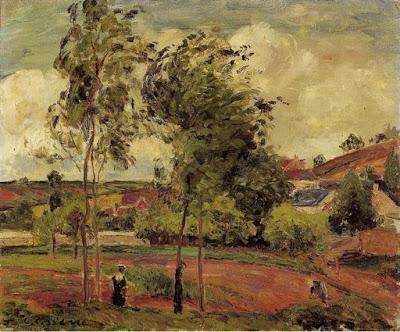
Strong Winds, Pontoise by Camille Pissarro
Q: One of my running buddies sent this article to me that suggests that speed and strength training do more for injury prevention than stretching and I don't buy it. Part of my argument is that stretching feels so good :) I'd love to know your thoughts that I can share with my running group. I think strength and speed definitely build the muscles and make them stronger, but its all yang, yang, yang!A: The article our reader is referring to is Impact of Stretching on the Performance and Injury Risk of Long-Distance Runners, a review article from 2015 that looked at all the available research on the effect of stretching on different aspects of endurance runners. The authors of the study were interested in finding out if stretching had any positive or negative impact on performance, if it improved recovery from post running soreness, and if it decreased the risk of distance running injuries. Because most research to date has focused on static stretching, usually with holds for 30 seconds, and very little on dynamic stretching, this study focused on reviewing studies that looked at static stretching. What they found might surprise many of us who that assume stretching—from yoga or otherwise—would provide benefits in all those areas. But it turns out this was not the case.Regarding the first question, stretching done just prior to running actually had negative effects on performance! And although stretching done at other times was not found to have any significant impact either way, the authors noted that a certain amount of stiffness in the hips and calves may actually confer better long distance running ability than being more flexible. They recommend not stretching just before running or at all. Many distance runners suffer from something called DOMS, or delayed onset muscular soreness, a condition of muscle soreness that can last a few days after longer runs, which can be temporarily disabling. It had been proposed that stretching may decrease the intensity and length of this condition, but the research reviewed in this study showed no effect from regular stretching on this condition. It has also often been proposed that regular stretching might reduce the risk of overuse injuries in long-distance runners, such as Achilles’ tendonitis, plantar fasciitis, or IT Band friction. But, again, the research showed no significant impact on injuries with regular stretching regimens. With three strikes against stretching, you long-distance runners out there might just give up on stretching altogether and by extension asana practices that focus more on flexibility. However, despite these three specific cases, I would propose that there are additional potential benefits to a well-rounded yoga practice for long distance runner that still includes some stretching. The investigators did make one interesting comment that is relevant: “As a result, unless stretching possesses other health or performance-related benefits, it appears to have little purpose in an endurance runner’ s preparation.”If we were to assume that a certain amount of stiffness in the hips and calves gives long distance runners an advantage in performance, we can easily design yoga practices that honor that, while still stretching other areas of the body that will benefit from improved flexibility, such as the spine and upper body. And I have noticed that despite being aerobically fit, runners often have poor overall posture. So a yoga practice could focus on improving posture as another goal, which will benefit you on and off the road. (We have written about the benefits of good posture in Friday Practical Pointers: Your Posture Affects Your Breathing and Cultivating Healthy Posture with a Simple Restorative Pose.)And Nina has reminded me that practicing yoga for healthy aging is not the same as practicing yoga for improved performance in running. If you completely neglect flexibility practices your whole life in order to improve your running, you risk suffering from loss of agility and ability to balance (not to mention the ability to move through daily activities with ease) when you’re older. So it makes sense to balance your strength building with some flexibility practices so you don’t become super stiff with age.Finally if we look beyond the limited focus on flexibility and stretching, there are many ways a well-rounded yoga practice can support those out there who love there 5K’s, 10K’s and beyond. The improved mental focus and internal awareness you achieve from pranayama and meditation could actually help performance—professional athletes report this regularly after adopting yoga practices. Restorative practices could improve recovery times in regards to energy and overall tissue healing. And, of course, static strengthening poses for the hips and legs could support strength and maintain the right amount of stiffness in calves and hips that competitive distance runners may want to preserve. —BaxterSubscribe to Yoga for Healthy Aging by Email ° Follow Yoga for Healthy Aging on Facebook ° Join this site with Google Friend Connect

